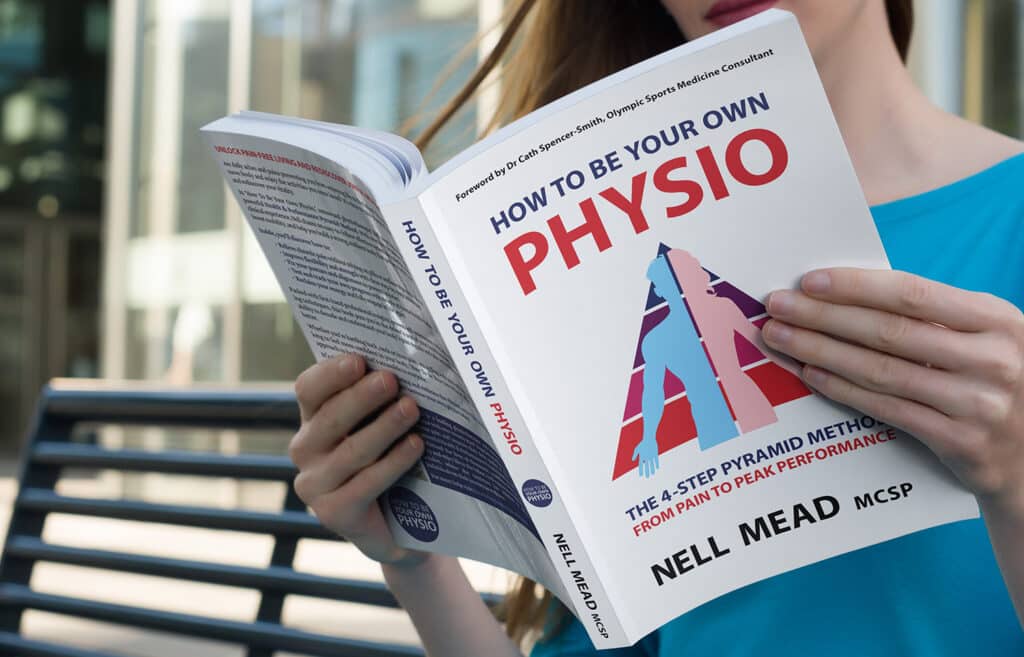Meet Bella
One of the patients I’ve been treating over the past year is a young lady called Bella. When I first met Bella, she was working as a fashion assistant, running all over London lugging heavy suitcases full of clothes for photoshoots, and I imagined her in the film The Devil Wears Prada! But Bella was struggling with a knee injury, and had been sent to me by her surgeon for exercises to help her improve the function of her right patellofemoral joint – the joint between the kneecap (patella) and the thigh bone (femur).
Bella had a knee injury…
By the time she saw me, Bella had had anterior knee pain for six months. She’d had an MRI scan that showed some damage to the retropatellar cartilage, which covers the back of the kneecap and keeps it healthy, but at only 23 years old, her surgeon sensibly felt that she was much better-off opting for physiotherapy for her knee injury, than surgery.
When I first saw her, it was obvious that Bella wasn’t moving well – in fact, she was limping badly, and was clearly in a lot of discomfort with her knee injury. It would have been easy to offer her the traditional treatment for patellofemoral problems: tape the patella, prescribe exercises to strengthen the quadriceps muscles at the front of the thigh, recommend keeping the knee straight.
…or did she?
I wasn’t convinced that Bella’s knee was the real issue.
When I assessed Bella, using Diane Lee’s Integrated Systems Model or ISM, her right hip just didn’t feel normal. It felt slightly twisted when she was standing, she couldn’t control it well when she transferred her weight from her left foot to her right, and its range of movement was restricted. And when I offloaded Bella’s hip with my hands, and compared her reaction to when I offloaded her knee, it was clear that offloading the hip gave her more relief, even though the pain was in her patellofemoral joint.
It wasn’t totally clear at this point exactly what damage she had done to her right hip, but I knew we needed to find out, so I referred her for another MRI scan – this time of her right hip.
The results came back quickly: Bella had a stress fracture in her hip socket! No wonder she’d been limping – and I think it was the limping that had caused the knee injury.
How Bella and I worked together
Stress fractures in weight bearing bones aren’t to be trifled with – if the stress fracture in the hip had got any bigger, it could have caused severe damage to Bella’s hip joint cartilage, which is not what you need at any age, but definitely not when you’re only 23! I immediately got Bella onto crutches, and kept her partial weight bearing until the stress fracture healed.
We then focused on restoring strength and control to Bella’s hip. It’s important to balance the muscles of the hip – the gluteal complex in the buttock, the hip flexors at the front, the adductors in the groin, and the external pelvic floor – so that you can keep the head of femur (the ball) in the middle of the acetabulum (the socket) and keep it moving smoothly. That way, you control the whole movement of the whole femur – and thus control the patellofemoral joint, so as to avoid risking a knee injury!
Why did it all happen?
Why did Bella damage her hip? Well, it turned out that she had hormone issues, and had been advised to take up intensive exercise to help control her hormone levels. Unfortunately, her endocrinologist hadn’t realised that Bella had never been a good mover, and I believe that her stress fracture was caused by a sudden increase in exercise volume and intensity, combined with underlying poor biomechanics – all very unlucky. Her job also didn’t help, with its combination of high stress levels and heavy loads.
How did it end?
Fortunately, Bella’s story has a relatively happy ending. There is some permanent damage to her hip joint cartilage, so she will have to take care of her body and maintain her strength and alignment – but the fracture has healed, she is off the crutches and able to exercise again, albeit not at the intensity and volume that broke her – and she is heading back to university to study for a Masters degree in psychology.
What does Bella think?
Bella was kind enough to write a few words about her experience:
Before my knee surgeon sent me to see Nell, I was limping all the time. My right side buckled constantly under my weight, so trying to get through the day was extremely hard physically. I found I couldn’t exercise, carry much or even walk properly, and it was hugely debilitating at the age of 23.
After a year of rehab with Nell (interrupted by Covid!) I have found that the constant pain, limping and buckling have gone. I’m currently building a support system with Nell to help my body work properly, and avoid the risk of more stress fractures. While this is a long process, I have never felt more in touch with my body and am seeing huge benefits from taking my time with Nell in order to fully understand my body and my nervous system.
Nell has helped me to find a connection between my brain and my hip muscles, which I couldn’t do before. I can now walk throughout the day without getting any serious pain – and if I do feel any discomfort, Nell has taught me to figure out where the pain is and what it’s trying to tell me.
Are you sure your knee injury is really coming from your knee? If you have a knee injury and it’s not responding to traditional knee treatment, it may be worth calling my team on 0207 175 0150 to book an assessment session with me. I’ll look at your whole body, and together we can analyse why your knee isn’t responding – and work out what’s really going on!







